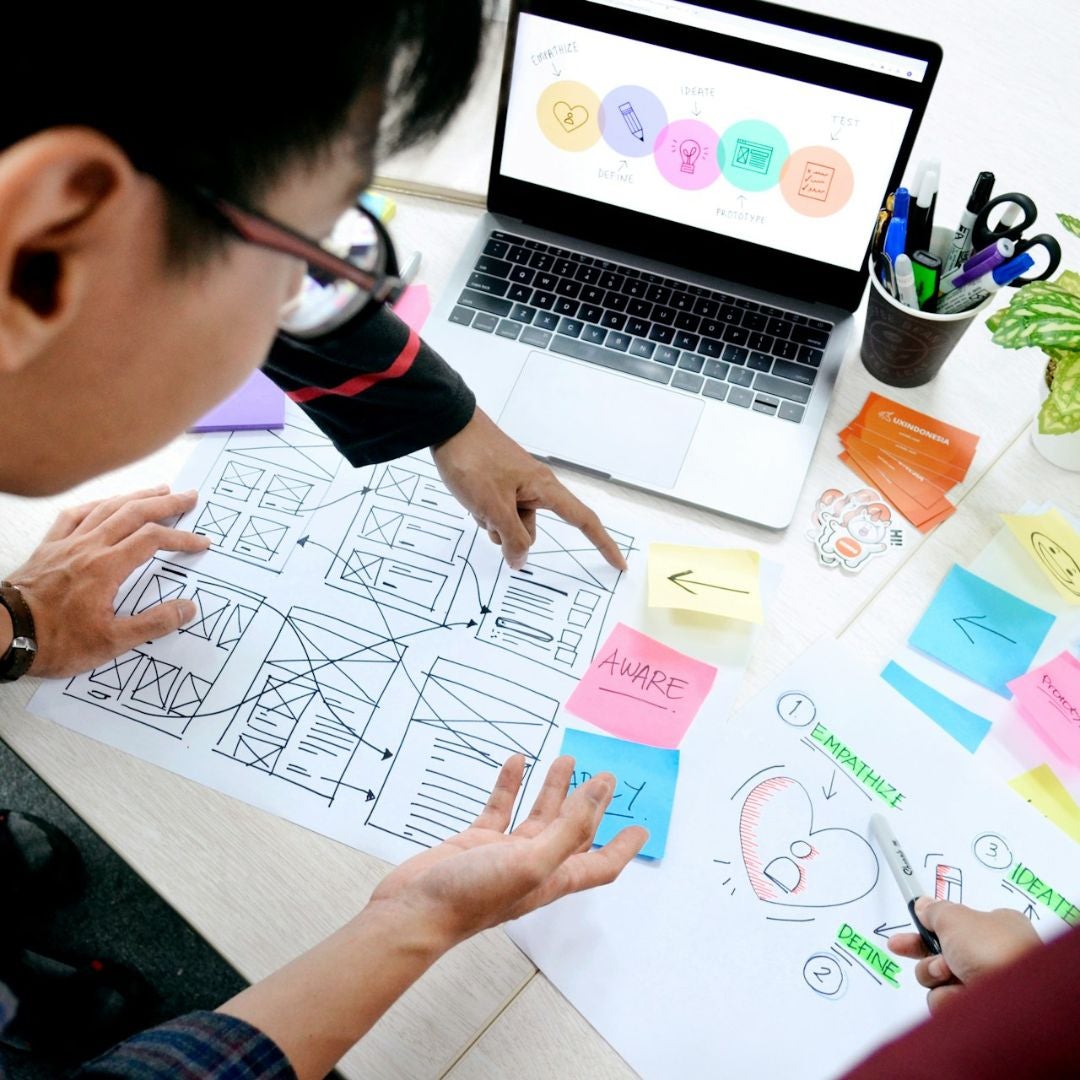
While it’s not a new approach, more and more businesses are paying attention to design thinking. It’s often the missing piece of the puzzle when product design goes wrong. In fact, according to Kevin Argus, design thinking can be applied to almost anything.
“Design thinking is all about reimagining what value looks like: better leadership for a better world, better marketing for a better world, better design for a better world. It’s not only the design of products and services but also of organisations.”
If you’re curious about how to implement design thinking in your role or organisation, here’s what you need to know.
What is design thinking?
At the heart of it, design thinking is human-centred design.
It’s so often the case that design is based on how you think someone will use a product, service or process. Design thinking puts the needs of the end user first and refines the product based on the user experience.
“Design thinking is predicated on conducting deep research to understand the stakeholders that you impact,” explains Argus.
“It’s a very inclusive approach where you try to get everyone involved in the design process to apply a diverse lens. It’s about thinking about what’s possible within the boundaries you have.”
What is the design thinking process?
Design thinking follows a five-step framework that’s iterative in nature. In a design thinking course, you would learn these steps in greater detail.
What is a design thinking approach? As an overview, the steps are:
- Empathise. The process starts with the user and understanding their needs through observation. This is done through empathy and without judgment.
- Define. Based on the observations gained from the first stage, you can then define the problem that needs to be solved.
- Ideate. With the problem identified, the next step involves brainstorming ideas in response to the problem. This is a creative and collaborative process rather than an individual one.
- Prototype. The next stage takes the ideas and creates a concrete product or fleshed-out concept that can be tested. The prototype isn’t the final product and doesn’t need to be perfect.
- Test. At this stage, the prototypes go to the end users for testing. This stage may also involve refining and more testing.
Key design thinking principles
The design thinking process is underpinned by a set of principles. These include:
- User-centricity. Rather than starting with a problem that needs to be solved, you allow your end-user observations to define the problem.
- Empathy. By stepping into the customer/end user's shoes, you can truly appreciate and understand the problem you need to solve.
- Experimentation. Through the experimentation process, you can test and refine based on user feedback.
- Action. While ideation is a critical stage in the process, design thinking is hands-on and requires action rather than conversation.
- Collaboration. Design thinking works best when you draw on diverse ideas and perspectives.
Why is design thinking important?
Why use design thinking? To demonstrate the value of the design thinking approach, Kevin Argus shares an example of a project he has worked on that involved reimagining the credit card of a large bank.
“People don’t visit branches like they used to, and they mostly do their banking online,” he says. “Their credit card is really the last tangible thing many people have as a connection to their bank.
“In looking at the design, accessibility and inclusivity were really important, so they included braille on the card, which is inclusive for blind people.
“But then through research, they also found that sustainability is an expectation of Gen Z and millennials, so that also informed the design.”
In design thinking, everyone is a designer, whether you’re the CEO or managing director, middle management or a teller in a bank branch. It’s not just up to one team to solve a problem; it’s a universal approach.
Design thinking solves concrete problems rather than problems that are imagined by people in head office, people who are often removed from the situation. A single management interview doesn’t define the trajectory. Real-life and real-user observations do. Plus, it also fosters innovation, collaboration and efficiency.
Learn more in a design thinking course
What skills can you get from a postgraduate business degree? Design thinking is likely one of them. You’ll learn what design thinking is in business and how to run a design thinking workshop. But more than that, you’ll have the practical skills to utilise design thinking to progress your career.
Given how valuable design thinking is for organisations today, many university programs include a design thinking unit as a core or elective subject. For example, the Graduate Certificate in Entrepreneurship and Innovation from The University of Queensland contains the Creativity for Innovation and Design Thinking unit, which focuses on how creativity and design thinking can be leveraged to identify opportunities. The unit also introduces design thinking tools that can be used in problem-solving.
Curtin University's Master of Innovation and Entrepreneurship offers a unit on design thinking as well. In this unit, you will be given a comprehensive introduction to design thinking as well as learn various research techniques that are often used in design thinking.
Discover some postgraduate courses that have a unit related to design thinking below.


The Graduate Certificate in Entrepreneurship and Innovation will teach you about understanding entrepreneurship and innovation in modern business and the benefits created, including better communities.
Upon graduation, you'll have a globally recognised qualification that is highly regarded by employers and gives you the skills to encourage innovation and entrepreneurship within any organisation, be it a corporation or startup, research organisation or in the public sector.


The Graduate Diploma in Entrepreneurship provides a unique pathway for graduates with aspirations to build, launch and grow their ideas. It is a practical and immersive learning journey where you can refine your entrepreneurial skills, gain hands-on experience, and transform your innovative ideas into impactful solutions.
Through the term-based structure, you'll have the opportunity to delve deeply into various aspects of entrepreneurship, fostering comprehensive growth and development throughout the one year program.


The course offers students opportunities to pursue and create new entities for social or economic impact, transform organisations and get exposure to business networks. The industry-relevant topics include a structured incubator followed by accelerator immersion.
This intensive program includes three stages for startup growth and entrepreneurial action. You can immerse yourself in an intensive “pre-accelerator”, generating and testing innovative ideas. “Incubate” your idea to grow and launch, with the support of our mentors and entrepreneurs in residence. Finally, “accelerate” your startup with industry connections and the right tools for scaling up.
The program focuses on the mindset, connections and skills required to navigate entrepreneurial pathways and the ecosystems for social or economic impact in any field. Participants will gain the skills to identify opportunities, solve problems in creative ways, transform ideas into value and address challenges in disruptive markets.


In addition to the specialist content, this course also offers opportunities to complete business internships and specialised programs such as the MIT Global Innovation Bootcamp and the Curtin Ignition commercialisation program. Throughout the course, you will gain the skills of entrepreneurship and intrapreneurship, business creativity and innovation and international marketing positioning and engagement. You’ll learn how to utilise those skills to unlock innovative opportunities and generate competitive solutions to complex issues in international business and entrepreneurship. You’ll explore the relationship between innovation and creativity as a business tool and study the application of design thinking to professional practice and entrepreneurship. You’ll also learn about ICT, analytics and data visualisation and experience business simulations in international business and entrepreneurial communications. Throughout the course, you’ll develop commercialisation, managerial and stakeholder engagement competencies in global business – including developing industry, executive and startup connections and networks.
You’ll also learn how to communicate effectively with culturally diverse stakeholders and First Nations Peoples and to consider the sustainability and impact of the business environment on society – all of which are increasingly important for ethical and professional practice in the modern world.
You’ll study real-world cases and undertake individual and team projects that apply leadership, innovation and entrepreneurship skills relevant to private companies and the public sector.
If you’re thinking, “Why study a postgraduate degree?”, design thinking is one big reason. The reality is that in an increasingly competitive market, having the knowledge and skills to implement design thinking is invaluable.
Design your next move
If you’re looking to develop your design thinking skills by pursuing a postgraduate qualification, take the first step and discover various courses from top Australian universities.




















